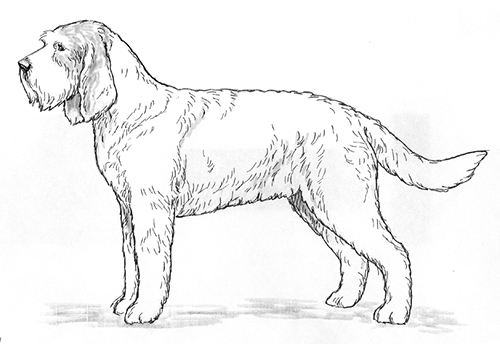Grand Griffon Vendeen
Scenthound Group
The goals and purposes of this breed standard include: to furnish guidelines for breeders who wish to maintain the quality of their breed and to improve it; to advance this breed to a state of similarity throughout the world; and to act as a guide for judges.
Breeders and judges have the responsibility to avoid any conditions or exaggerations that are detrimental to the health, welfare, essence and soundness of this breed, and must take the responsibility to see that these are not perpetuated.
Any departure from the following should be considered a fault, and the seriousness with which the fault should be regarded should be in exact proportion to its degree and its effect upon the health and welfare of the dog and on the dog’s ability to perform its traditional work.
History
In the early 16th Century, a breed known as the Grand Vendeen existed. It was a short coated Vendeen bred down from ‘the King’s white hounds’. When the Grand Vendeen was crossed with several of the other Griffon breeds, the Grand Griffon Vendeen was born. It was used on large game such as stag, roe deer, wild boar and fox, generally in a pack.
The Grand Griffon Vendeen was recognized by the United Kennel Club January 1, 1996.
General Appearance
A distinguished breed, very French in type, the Grand Griffon Vendeen is well proportioned and robust without being heavy.
Characteristics
Docile, but willful and passionate because of its strong hunting instinct, the Grand Griffon Vendeen has to be kept well in hand.
Head
SKULL
The skull is not too wide. Viewed from the front, it is fairly well domed. The stop is slightly defined.
Fault: Flat skull.
MUZZLE
The muzzle is as long as the skull. It is strong, and has a straight or slightly convex nasal bone. The lips are pendulous and well cover the lower jaw, giving the muzzle a square appearance.
TEETH
The Grand Griffon Vendeen has a complete set of evenly spaced, white teeth meeting in a scissors bite.
Fault: Level bite.
Disqualifications: Overshot or undershot.
NOSE
Large, with well opened nostrils, the nose is black except in white and orange dogs, which may have brown noses. It must be fully pigmented.
Disqualification: Dudley nose.
EYES
The eyes are large, dark and bright, with tight rims that are fully pigmented.
Fault: Light eyes.
Disqualification: Wall eyes.
EARS
The ears are supple, narrow and fine, ending in an elongated oval. They are set below the level of the eye and must reach beyond the end of the nose.
Faults: High set ears. Short ears.
Neck
Elegant, with no dewlap.
Forequarters
The forequarters are powerful, with long, lean, sloping shoulders.
FORELEGS
The elbows are close to the body, and the forearms are straight with strong bone and fairly upright pasterns.
Body
The chest is deep to the elbow but not too wide. The ribs are long and moderately rounded. The back is solid, and is straight or slightly sloping. The loin is well muscled and the croup is flat. The flank is slightly tucked up.
Hindquarters
The hindquarters are solid, with hip bones that are apparent.
HIND LEGS
The thighs are long and muscular. The hock joint is broad and well let down, with moderate angulation.
Feet
Well arched and tight, with solid pads and strong nails. Good pigment is preferred.
Tail
The tail is rather long, thick at the base, and tapering towards the tip. It is set high and carried in saber fashion, but never curled over the back.
Disqualification: Kinked tail.
Coat
Fairly long, coarse and hard, with a dense undercoat. The eyebrows and moustache are well pronounced, but the eyebrows must not cover the eyes.
Fault: Coat too fine.
Disqualification: Woolly coat.
Color
White and black, white and orange, black and tan, tricolor, fawn with black overlay (with or without white spotting). Traditional colors such as hare, wolf, badger or wild boar.
Disqualifications: Solid white or solid black.
Height
Height at the withers for males is 24.5 to 27.5 inches. For females, it is 23.5 to 25.5 inches.
Gait
Supple, even and active.
Eliminating Faults
(An Eliminating Fault is a Fault serious enough that it eliminates the dog from obtaining any awards in a conformation event.)
Oversize or undersize.
Disqualifications
(A dog with a Disqualification must not be considered for placement in a conformation event, and must be reported to UKC.)
Unilateral or bilateral cryptorchid.
Viciousness or extreme shyness.
Albinism.
Overshot or undershot.
Dudley nose.
Wall eyes.
Kinked tail.
Woolly coat.
Solid white or solid black.

Looking for a Dog?
Find a dog that will fit your family.
Note: The breeders on this list are not endorsed by UKC.
Revised July 1, 2009
©Copyright 1996, United Kennel Club
